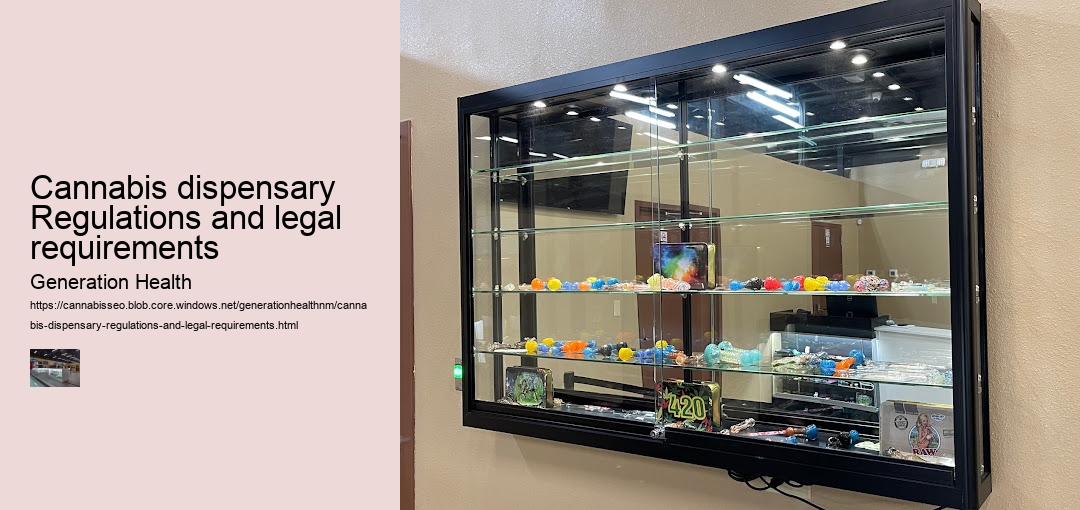

Opening a cannabis dispensary can be an exciting venture, but it's important to understand the licensing requirements that come with it. In order to legally operate a cannabis dispensary, you must obtain the necessary licenses and permits from your state or local government.
These licensing requirements vary from state to state, so it's crucial to research and understand the specific regulations in your area. Some common requirements include obtaining a business license, a seller's permit, and a cannabis-specific license.
Additionally, many states have strict regulations on who can own and operate a cannabis dispensary. This often includes background checks and residency requirements. It's also important to note that some states have limited the number of dispensaries that can be opened in a certain area, so competition for licenses can be fierce.
Overall, navigating the licensing requirements for opening a cannabis dispensary can be complex and time-consuming. It's essential to do thorough research and seek legal guidance to ensure that you are compliant with all regulations before opening your doors for business.
Security measures and protocols are essential components of operating a cannabis dispensary in compliance with regulations and legal requirements. These measures are put in place to ensure the safety of employees, customers, and the product itself.
One of the most crucial security measures for cannabis dispensaries is having a robust surveillance system in place. This typically includes cameras strategically placed throughout the dispensary to monitor all areas where cannabis products are stored or sold. The footage from these cameras must be stored securely and retained for a specific period as mandated by law.
In addition to surveillance, dispensaries must also have strict access control protocols. This means limiting entry into certain areas of the dispensary to only authorized personnel. This can include using keycard systems, biometric scanners, or other forms of secure access control.
Furthermore, dispensaries must have proper alarm systems in place to alert authorities in case of any security breaches or emergencies. These alarms should be monitored 24/7 to ensure a rapid response if needed.
Lastly, dispensaries must also adhere to regulations regarding transportation and storage of cannabis products. This often includes requirements for secure transport vehicles and storage facilities that meet specific security standards.
Overall, these security measures and protocols are necessary not only for compliance with regulations but also for the safety and well-being of everyone involved in the operation of a cannabis dispensary. By implementing these measures effectively, dispensaries can operate confidently within the bounds of the law while providing a safe environment for their employees and customers alike.
Product testing and labeling requirements for cannabis products are essential aspects of operating a cannabis dispensary. These regulations ensure that consumers have access to safe and accurately labeled products.
Product testing is crucial for verifying the potency and purity of cannabis products. It involves analyzing samples for levels of cannabinoids, pesticides, heavy metals, and other contaminants. This information helps consumers make informed decisions about their purchases and ensures that they are not exposed to harmful substances.
Labeling requirements provide important information to consumers, such as the potency of the product, recommended dosage, and potential side effects. Clear and accurate labeling helps customers understand what they are purchasing and how to use it safely.
Compliance with product testing and labeling requirements is necessary to maintain the integrity of the cannabis industry and protect public health. Dispensaries must adhere to these regulations to build trust with their customers and demonstrate their commitment to providing high-quality products.
Overall, product testing and labeling requirements play a vital role in ensuring the safety and transparency of cannabis products sold at dispensaries. By following these regulations, dispensaries can uphold industry standards and promote responsible consumption within the community.
When it comes to advertising restrictions and marketing guidelines for cannabis dispensaries, there are a few key factors that need to be taken into consideration. Due to the legal status of cannabis in many places, there are strict regulations in place regarding how dispensaries can promote their products.
One of the most important things to keep in mind is that advertising must not target minors or individuals under the legal age for consuming cannabis. This means that any marketing materials, whether they be online or in print, must be designed in a way that does not appeal to those who are underage.
Additionally, dispensaries must also ensure that their advertising does not make any false claims about the effects of their products. This includes refraining from making any medical claims unless they have been approved by the relevant authorities.
In terms of marketing guidelines, it is crucial for dispensaries to use discretion when promoting their products. This means avoiding flashy or over-the-top advertisements that could be seen as promoting excessive consumption.
Overall, while there may be some limitations on how cannabis dispensaries can advertise and market their products, these restrictions are put in place to protect consumers and ensure that the industry operates in a responsible manner. By following these guidelines, dispensaries can help build trust with their customers and contribute to the overall legitimacy of the cannabis industry.
When it comes to working in a cannabis dispensary, there are specific regulations and legal requirements that must be followed. One of the key aspects of these requirements is employee training and background checks.
Employees who work in cannabis dispensaries must undergo thorough training to ensure they understand the laws and regulations surrounding the industry. This training may cover topics such as proper product handling, customer service, and compliance with state laws. It is important for employees to be well-informed about the products they are selling and how to safely and legally operate within the industry.
In addition to training, employees must also pass background checks before being allowed to work in a cannabis dispensary. These checks help ensure that employees have not been convicted of any drug-related offenses or other crimes that could potentially impact their ability to work in the industry. Background checks are essential for maintaining the integrity and safety of cannabis dispensaries.
Overall, employee training and background check requirements are crucial components of operating a successful and compliant cannabis dispensary. By ensuring that employees are well-trained and have clean backgrounds, dispensaries can provide customers with quality products while staying on the right side of the law.
Compliance with local, state, and federal laws governing the sale of cannabis products is essential for any cannabis dispensary to operate legally and successfully. These laws are in place to ensure that the sale of cannabis products is done in a safe and responsible manner, while also protecting consumers from potential harm.
Local laws vary from city to city and can include regulations on where dispensaries can be located, hours of operation, and security measures. State laws typically outline licensing requirements, product testing standards, and taxation guidelines. Federal laws, although still prohibiting cannabis at the national level, focus on issues like interstate transportation of marijuana and banking restrictions for dispensaries.
By adhering to these regulations, dispensaries can avoid costly fines or even being shut down. It also helps build trust with customers who want to purchase their products from a reputable source that follows the law.
In order to stay compliant, dispensaries must stay informed about any changes in legislation and make sure their operations are up to standard. This may require hiring legal counsel or compliance officers to navigate the complex web of regulations.
Ultimately, compliance with local, state, and federal laws is crucial for the long-term success of a cannabis dispensary. It not only ensures legal operation but also promotes a positive image within the community and industry as a whole.
Non-compliance with cannabis dispensary regulations can have serious consequences for both the business and the individuals involved. These regulations are put in place to ensure that dispensaries operate safely, ethically, and in accordance with the law. Failure to comply with these regulations can result in fines, license suspension or revocation, and even criminal charges.
One of the main consequences of non-compliance is financial penalties. Dispensaries that fail to follow the rules set forth by local and state authorities can face hefty fines that can significantly impact their bottom line. These fines are meant to serve as a deterrent to prevent future violations and encourage dispensaries to take compliance seriously.
In addition to financial penalties, non-compliance can also lead to the suspension or revocation of a dispensary's license. Without a valid license, a dispensary cannot legally operate, effectively shutting down the business until the necessary requirements are met. This can have devastating consequences for both the dispensary owner and their employees.
Furthermore, non-compliance with cannabis dispensary regulations can also result in criminal charges. Operating outside of the law can lead to charges such as drug trafficking or distribution, which carry serious legal ramifications including fines and imprisonment.
Overall, it is crucial for cannabis dispensaries to understand and adhere to all regulatory requirements in order to avoid these negative consequences. By staying compliant with laws and regulations, dispensaries can protect their business, reputation, and livelihood while contributing to a safer and more transparent industry as a whole.


Cannabis dispensaries in the United States or marijuana dispensaries are a type of cannabis retail outlet, local government-regulated physical location, typically inside a retail storefront or office building, in which a person can purchase cannabis and cannabis-related items for medical or recreational use.
First modeled in Amsterdam in the late 1970s where they were innocently called coffeeshops, it would take the Americans more than a generation to successfully duplicate the idea of a retail cannabis storefront. Unlike in the Dutch coffee shops, today most dispensaries do not allow for the smoking or other consumption of cannabis. However, some dispensaries (such as some in California) do have legal permission to set up "cannabars" to allow onsite consumption.
In a traditional medical cannabis dispensary store a patient receives cannabis medication as allowed per the patient's doctor's recommendation.[1] These dispensaries sell cannabis products that have not been approved by the FDA and are not legally registered with the federal government.[2]
As of 2021 there are state-regulated marijuana dispensaries in Alaska, Arizona, Arkansas, California, Colorado, Connecticut, the District of Columbia, Florida, Hawaii, Illinois, Louisiana, Maine, Maryland, Massachusetts, Michigan, Minnesota, Missouri, Montana, Nevada, New Hampshire, New Jersey, New Mexico, New York, North Dakota, Ohio, Oklahoma, Oregon, Pennsylvania, Rhode Island, Utah, Vermont, Virginia, and Washington. In California, Native American gaming operations are also intended to include dispensaries going forward.[3]
A cannabis dispensary differs from similar retail stores known as head shops, in that only state-licensed cannabis dispensaries are authorized to sell cannabis.[4][5]
Approximately 14 US States have drive thru capabilities. These states include; California, Colorado, Illinois, Maryland, Michigan, Missouri, Nevada, New Jersey, Pennsylvania, Ohio, Oklahoma, Oregon, Utah, and Washington[6][7][8]
The first dispensary San Francisco Cannabis Buyers Club was founded in 1992 by Proposition 215 coauthors "Brownie Mary" Rathbun, Dennis Peron and Dale Gieringer.[9] Shortly after was founded the Berkeley Patients Group, remaining as of 2024 the oldest continuously-operating dispensary in the country.[10]
Washington state became the second state in the U.S. to develop a regulatory framework for marijuana dispensary operators to improve the access to cannabis patients beyond the caregiver model.[11]
The term "marijuana dispensary" in the United States is most often used to refer to private organizations or companies that sell cannabis, particularly in the states of California, Colorado, Washington and Oregon. "Cannabis dispensary" is starting to become a more politically correct term as conscientious people prefer the use of the word cannabis which avoids using the more common Spanish slang word "marijuana".[citation needed]
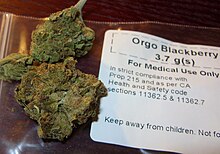
Thirty seven of the United States regulate some form of medical cannabis sales despite federal laws.[12] As of 2016 seventeen of those states (Arizona, California, Colorado, Connecticut, Delaware, Illinois, Maine, Michigan, Montana, Nevada, New Jersey, New Mexico, New York, Oklahoma, Oregon, Rhode Island, Washington, and Washington, D.C.) have at least one medical marijuana dispensary, with varying product laws.[13]
The medical dispensaries in these states buy their exit shop products (excluding medical marijuana), like child-proof safety bags, and in-store storage products, from a plethora of new manufacturing companies in mainly China via importers based in the U.S.
The growing need of dispensaries to comply with various legislative laws has given birth to thousands of new products ranging from vials with child locks on them to, to pop top bottles that are childproof[14] and even childproof joint tubes.
For example, under Washington state law,[15] any marijuana products, whether they are edibles, concentrates, or waxes that can be consumed either by inhaling or swallowing must be sold in child-resistant packaging consistent with the regulations of 16 CFR 1700 under the Poison Prevention Packaging Act.
Colorado was the first state to license a Recreational Dispensary, with 37 stores licensed to sell to adults 21+ on January 1, 2014. The first customer on record to legally purchase marijuana was Sean Azzarati, an Iraq war veteran, who was raising awareness for the cause that PTSD was not a "qualifying condition" for a medical marijuana recommendation in Colorado at the time (PTSD was added to the list of qualifying conditions in 2017).[16]

As of March 2024, 25 states regulate recreational dispensaries.[17] A partial list includes Alaska (Alaska Measure 2 (2014)), Arizona (2020 Arizona Proposition 207), California (2018), Colorado (Colorado Amendment 64), Illinois (2020), Maine (2020), Massachusetts (2018), Nevada (2017), Oregon (Oregon Ballot Measure 91 (2014)), Michigan, and Washington (Washington Initiative 502).[18] These are stores where any adult 21+ can enter to purchase cannabis and or cannabis smoking accessories.
Harborside Health Center, Oakland and San Jose, California describes itself as the "largest pot shop" in California[19] and was featured in a four-part reality show.[20]
An economic impact study conducted by the University of Denver examined the Colorado Harvest Company dispensary chain's contribution to tax revenue, jobs, and income to Denver and the state of Colorado.[21]
Kind for Cures was the first shop to make national press by taking over a defunct KFC.[22]
Coachella Valley Church in San Jose, California made national headlines by offering sacramental marijuana to their members.[23]
MedMen's operation grew to include thousands of employees, dozens of retail locations across multiple states in addition to processing and grow facilities; MedMen aims to be the “Apple Store” of weed.[citation needed]
As dispensaries grow in popularity, several locating services have been created such as NearGreen, Leafbuyer, Weedmaps, Texas Weed Syndicate, Merry Jane and Leafly[24]

Weed Wars is a four-part reality show broadcast on the Discovery Channel which highlights the Harborside Health Center in Oakland California, a medical marijuana dispensary.[25]
The third episode of the 14th season of South Park is named "Medicinal Fried Chicken" and contemplates a marijuana dispensary taking over a recently closed fast-food chicken restaurant named "KFC".
Popular American comedian D. L. Hughley's short-lived and controversial news program on CNN ends with the artist visiting a California dispensary to treat back pain.
cite journal: Cite journal requires |journal= (help)
| Cannabis
Temporal range: Early Miocene – Present
|
|
|---|---|
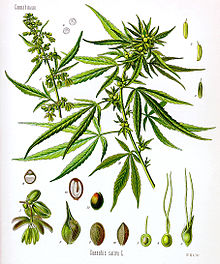 |
|
| Common hemp | |
| Scientific classification |
|
| Kingdom: | Plantae |
| Clade: | Tracheophytes |
| Clade: | Angiosperms |
| Clade: | Eudicots |
| Clade: | Rosids |
| Order: | Rosales |
| Family: | Cannabaceae |
| Genus: | Cannabis L. |
| Species[1] | |
|
|
| Part of a series on |
| Cannabis |
|---|
 |
Cannabis (/ˈkænÉ™bɪs/ ⓘ)[2] is a genus of flowering plants in the family Cannabaceae that is widely accepted as being indigenous to and originating from the continent of Asia.[3][4][5] However, the number of species is disputed, with as many as three species being recognized: Cannabis sativa, C. indica, and C. ruderalis. Alternatively, C. ruderalis may be included within C. sativa, or all three may be treated as subspecies of C. sativa,[1][6][7][8] or C. sativa may be accepted as a single undivided species.[9]
The plant is also known as hemp, although this term is usually used to refer only to varieties cultivated for non-drug use. Hemp has long been used for fibre, seeds and their oils, leaves for use as vegetables, and juice. Industrial hemp textile products are made from cannabis plants selected to produce an abundance of fibre.
Cannabis also has a long history of being used for medicinal purposes, and as a recreational drug known by several slang terms, such as marijuana, pot or weed. Various cannabis strains have been bred, often selectively to produce high or low levels of tetrahydrocannabinol (THC), a cannabinoid and the plant's principal psychoactive constituent. Compounds such as hashish and hash oil are extracted from the plant.[10] More recently, there has been interest in other cannabinoids like cannabidiol (CBD), cannabigerol (CBG), and cannabinol (CBN).
Cannabis is a Scythian word.[11][12][13] The ancient Greeks learned of the use of cannabis by observing Scythian funerals, during which cannabis was consumed.[12] In Akkadian, cannabis was known as qunubu (ðŽ¯ðŽ«ðŽ ðŽð‚).[12] The word was adopted in to the Hebrew language as qaneh bosem (×§Ö¸× Ö¶×” בֹּשׂ×).[12]


Cannabis is an annual, dioecious, flowering herb. The leaves are palmately compound or digitate, with serrate leaflets.[14] The first pair of leaves usually have a single leaflet, the number gradually increasing up to a maximum of about thirteen leaflets per leaf (usually seven or nine), depending on variety and growing conditions. At the top of a flowering plant, this number again diminishes to a single leaflet per leaf. The lower leaf pairs usually occur in an opposite leaf arrangement and the upper leaf pairs in an alternate arrangement on the main stem of a mature plant.
The leaves have a peculiar and diagnostic venation pattern (which varies slightly among varieties) that allows for easy identification of Cannabis leaves from unrelated species with similar leaves. As is common in serrated leaves, each serration has a central vein extending to its tip, but in Cannabis this originates from lower down the central vein of the leaflet, typically opposite to the position of the second notch down. This means that on its way from the midrib of the leaflet to the point of the serration, the vein serving the tip of the serration passes close by the intervening notch. Sometimes the vein will pass tangentially to the notch, but often will pass by at a small distance; when the latter happens a spur vein (or occasionally two) branches off and joins the leaf margin at the deepest point of the notch. Tiny samples of Cannabis also can be identified with precision by microscopic examination of leaf cells and similar features, requiring special equipment and expertise.[15]
All known strains of Cannabis are wind-pollinated[16] and the fruit is an achene.[17] Most strains of Cannabis are short day plants,[16] with the possible exception of C. sativa subsp. sativa var. spontanea (= C. ruderalis), which is commonly described as "auto-flowering" and may be day-neutral.
Cannabis is predominantly dioecious,[16][18] having imperfect flowers, with staminate "male" and pistillate "female" flowers occurring on separate plants.[19] "At a very early period the Chinese recognized the Cannabis plant as dioecious",[20] and the (c. 3rd century BCE) Erya dictionary defined xi 枲 "male Cannabis" and fu 莩 (or ju 苴) "female Cannabis".[21] Male flowers are normally borne on loose panicles, and female flowers are borne on racemes.[22]
Many monoecious varieties have also been described,[23] in which individual plants bear both male and female flowers.[24] (Although monoecious plants are often referred to as "hermaphrodites", true hermaphrodites – which are less common in Cannabis – bear staminate and pistillate structures together on individual flowers, whereas monoecious plants bear male and female flowers at different locations on the same plant.) Subdioecy (the occurrence of monoecious individuals and dioecious individuals within the same population) is widespread.[25][26][27] Many populations have been described as sexually labile.[28][29][30]
As a result of intensive selection in cultivation, Cannabis exhibits many sexual phenotypes that can be described in terms of the ratio of female to male flowers occurring in the individual, or typical in the cultivar.[31] Dioecious varieties are preferred for drug production, where the fruits (produced by female flowers) are used. Dioecious varieties are also preferred for textile fiber production, whereas monoecious varieties are preferred for pulp and paper production. It has been suggested that the presence of monoecy can be used to differentiate licit crops of monoecious hemp from illicit drug crops,[25] but sativa strains often produce monoecious individuals, which is possibly as a result of inbreeding.

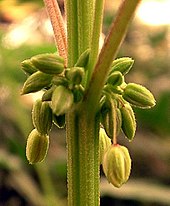
Cannabis has been described as having one of the most complicated mechanisms of sex determination among the dioecious plants.[31] Many models have been proposed to explain sex determination in Cannabis.
Based on studies of sex reversal in hemp, it was first reported by K. Hirata in 1924 that an XY sex-determination system is present.[29] At the time, the XY system was the only known system of sex determination. The X:A system was first described in Drosophila spp in 1925.[32] Soon thereafter, Schaffner disputed Hirata's interpretation,[33] and published results from his own studies of sex reversal in hemp, concluding that an X:A system was in use and that furthermore sex was strongly influenced by environmental conditions.[30]
Since then, many different types of sex determination systems have been discovered, particularly in plants.[18] Dioecy is relatively uncommon in the plant kingdom, and a very low percentage of dioecious plant species have been determined to use the XY system. In most cases where the XY system is found it is believed to have evolved recently and independently.[34]
Since the 1920s, a number of sex determination models have been proposed for Cannabis. Ainsworth describes sex determination in the genus as using "an X/autosome dosage type".[18]
The question of whether heteromorphic sex chromosomes are indeed present is most conveniently answered if such chromosomes were clearly visible in a karyotype. Cannabis was one of the first plant species to be karyotyped; however, this was in a period when karyotype preparation was primitive by modern standards. Heteromorphic sex chromosomes were reported to occur in staminate individuals of dioecious "Kentucky" hemp, but were not found in pistillate individuals of the same variety. Dioecious "Kentucky" hemp was assumed to use an XY mechanism. Heterosomes were not observed in analyzed individuals of monoecious "Kentucky" hemp, nor in an unidentified German cultivar. These varieties were assumed to have sex chromosome composition XX.[35] According to other researchers, no modern karyotype of Cannabis had been published as of 1996.[36] Proponents of the XY system state that Y chromosome is slightly larger than the X, but difficult to differentiate cytologically.[37]
More recently, Sakamoto and various co-authors[38][39] have used random amplification of polymorphic DNA (RAPD) to isolate several genetic marker sequences that they name Male-Associated DNA in Cannabis (MADC), and which they interpret as indirect evidence of a male chromosome. Several other research groups have reported identification of male-associated markers using RAPD and amplified fragment length polymorphism.[40][28][41] Ainsworth commented on these findings, stating,
It is not surprising that male-associated markers are relatively abundant. In dioecious plants where sex chromosomes have not been identified, markers for maleness indicate either the presence of sex chromosomes which have not been distinguished by cytological methods or that the marker is tightly linked to a gene involved in sex determination.[18]
Environmental sex determination is known to occur in a variety of species.[42] Many researchers have suggested that sex in Cannabis is determined or strongly influenced by environmental factors.[30] Ainsworth reviews that treatment with auxin and ethylene have feminizing effects, and that treatment with cytokinins and gibberellins have masculinizing effects.[18] It has been reported that sex can be reversed in Cannabis using chemical treatment.[43] A polymerase chain reaction-based method for the detection of female-associated DNA polymorphisms by genotyping has been developed.[44]
Cannabis plants produce a large number of chemicals as part of their defense against herbivory. One group of these is called cannabinoids, which induce mental and physical effects when consumed.
Cannabinoids, terpenes, terpenoids, and other compounds are secreted by glandular trichomes that occur most abundantly on the floral calyxes and bracts of female plants.[46]
Cannabis, like many organisms, is diploid, having a chromosome complement of 2n=20, although polyploid individuals have been artificially produced.[47] The first genome sequence of Cannabis, which is estimated to be 820 Mb in size, was published in 2011 by a team of Canadian scientists.[48]

The genus Cannabis was formerly placed in the nettle family (Urticaceae) or mulberry family (Moraceae), and later, along with the genus Humulus (hops), in a separate family, the hemp family (Cannabaceae sensu stricto).[49] Recent phylogenetic studies based on cpDNA restriction site analysis and gene sequencing strongly suggest that the Cannabaceae sensu stricto arose from within the former family Celtidaceae, and that the two families should be merged to form a single monophyletic family, the Cannabaceae sensu lato.[50][51]
Various types of Cannabis have been described, and variously classified as species, subspecies, or varieties:[52]
Cannabis plants produce a unique family of terpeno-phenolic compounds called cannabinoids, some of which produce the "high" which may be experienced from consuming marijuana. There are 483 identifiable chemical constituents known to exist in the cannabis plant,[53] and at least 85 different cannabinoids have been isolated from the plant.[54] The two cannabinoids usually produced in greatest abundance are cannabidiol (CBD) and/or Δ9-tetrahydrocannabinol (THC), but only THC is psychoactive.[55] Since the early 1970s, Cannabis plants have been categorized by their chemical phenotype or "chemotype", based on the overall amount of THC produced, and on the ratio of THC to CBD.[56] Although overall cannabinoid production is influenced by environmental factors, the THC/CBD ratio is genetically determined and remains fixed throughout the life of a plant.[40] Non-drug plants produce relatively low levels of THC and high levels of CBD, while drug plants produce high levels of THC and low levels of CBD. When plants of these two chemotypes cross-pollinate, the plants in the first filial (F1) generation have an intermediate chemotype and produce intermediate amounts of CBD and THC. Female plants of this chemotype may produce enough THC to be utilized for drug production.[56][57]
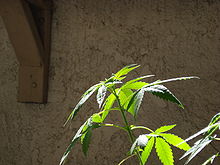
Whether the drug and non-drug, cultivated and wild types of Cannabis constitute a single, highly variable species, or the genus is polytypic with more than one species, has been a subject of debate for well over two centuries. This is a contentious issue because there is no universally accepted definition of a species.[58] One widely applied criterion for species recognition is that species are "groups of actually or potentially interbreeding natural populations which are reproductively isolated from other such groups."[59] Populations that are physiologically capable of interbreeding, but morphologically or genetically divergent and isolated by geography or ecology, are sometimes considered to be separate species.[59] Physiological barriers to reproduction are not known to occur within Cannabis, and plants from widely divergent sources are interfertile.[47] However, physical barriers to gene exchange (such as the Himalayan mountain range) might have enabled Cannabis gene pools to diverge before the onset of human intervention, resulting in speciation.[60] It remains controversial whether sufficient morphological and genetic divergence occurs within the genus as a result of geographical or ecological isolation to justify recognition of more than one species.[61][62][63]
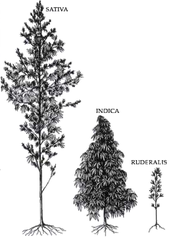
The genus Cannabis was first classified using the "modern" system of taxonomic nomenclature by Carl Linnaeus in 1753, who devised the system still in use for the naming of species.[64] He considered the genus to be monotypic, having just a single species that he named Cannabis sativa L.[a 1] Linnaeus was familiar with European hemp, which was widely cultivated at the time. This classification was supported by Christiaan Hendrik Persoon (in 1807), Lindley (in 1838) and De Candollee (in 1867). These first classification attempts resulted in a four group division:[65]
In 1785, evolutionary biologist Jean-Baptiste de Lamarck published a description of a second species of Cannabis, which he named Cannabis indica Lam.[66] Lamarck based his description of the newly named species on morphological aspects (trichomes, leaf shape) and geographic localization of plant specimens collected in India. He described C. indica as having poorer fiber quality than C. sativa, but greater utility as an inebriant. Also, C. indica was considered smaller, by Lamarck. Also, woodier stems, alternate ramifications of the branches, narrow leaflets, and a villous calyx in the female flowers were characteristics noted by the botanist.[65]
In 1843, William O’Shaughnessy, used "Indian hemp (C. indica)" in a work title. The author claimed that this choice wasn't based on a clear distinction between C. sativa and C. indica, but may have been influenced by the choice to use the term "Indian hemp" (linked to the plant's history in India), hence naming the species as indica.[65]
Additional Cannabis species were proposed in the 19th century, including strains from China and Vietnam (Indo-China) assigned the names Cannabis chinensis Delile, and Cannabis gigantea Delile ex Vilmorin.[67] However, many taxonomists found these putative species difficult to distinguish. In the early 20th century, the single-species concept (monotypic classification) was still widely accepted, except in the Soviet Union, where Cannabis continued to be the subject of active taxonomic study. The name Cannabis indica was listed in various Pharmacopoeias, and was widely used to designate Cannabis suitable for the manufacture of medicinal preparations.[68]
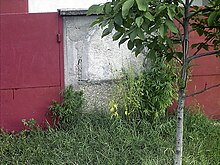
In 1924, Russian botanist D.E. Janichevsky concluded that ruderal Cannabis in central Russia is either a variety of C. sativa or a separate species, and proposed C. sativa L. var. ruderalis Janisch, and Cannabis ruderalis Janisch, as alternative names.[52] In 1929, renowned plant explorer Nikolai Vavilov assigned wild or feral populations of Cannabis in Afghanistan to C. indica Lam. var. kafiristanica Vav., and ruderal populations in Europe to C. sativa L. var. spontanea Vav.[57][67] Vavilov, in 1931, proposed a three species system, independently reinforced by Schultes et al (1975)[69] and Emboden (1974):[70] C. sativa, C. indica and C. ruderalis.[65]
In 1940, Russian botanists Serebriakova and Sizov proposed a complex poly-species classification in which they also recognized C. sativa and C. indica as separate species. Within C. sativa they recognized two subspecies: C. sativa L. subsp. culta Serebr. (consisting of cultivated plants), and C. sativa L. subsp. spontanea (Vav.) Serebr. (consisting of wild or feral plants). Serebriakova and Sizov split the two C. sativa subspecies into 13 varieties, including four distinct groups within subspecies culta. However, they did not divide C. indica into subspecies or varieties.[52][71][72] Zhukovski, in 1950, also proposed a two-species system, but with C. sativa L. and C. ruderalis.[73]
In the 1970s, the taxonomic classification of Cannabis took on added significance in North America. Laws prohibiting Cannabis in the United States and Canada specifically named products of C. sativa as prohibited materials. Enterprising attorneys for the defense in a few drug busts argued that the seized Cannabis material may not have been C. sativa, and was therefore not prohibited by law. Attorneys on both sides recruited botanists to provide expert testimony. Among those testifying for the prosecution was Dr. Ernest Small, while Dr. Richard E. Schultes and others testified for the defense. The botanists engaged in heated debate (outside of court), and both camps impugned the other's integrity.[61][62] The defense attorneys were not often successful in winning their case, because the intent of the law was clear.[74]

In 1976, Canadian botanist Ernest Small[75] and American taxonomist Arthur Cronquist published a taxonomic revision that recognizes a single species of Cannabis with two subspecies (hemp or drug; based on THC and CBD levels) and two varieties in each (domesticated or wild). The framework is thus:
This classification was based on several factors including interfertility, chromosome uniformity, chemotype, and numerical analysis of phenotypic characters.[56][67][76]
Professors William Emboden, Loran Anderson, and Harvard botanist Richard E. Schultes and coworkers also conducted taxonomic studies of Cannabis in the 1970s, and concluded that stable morphological differences exist that support recognition of at least three species, C. sativa, C. indica, and C. ruderalis.[77][78][79][80] For Schultes, this was a reversal of his previous interpretation that Cannabis is monotypic, with only a single species.[81] According to Schultes' and Anderson's descriptions, C. sativa is tall and laxly branched with relatively narrow leaflets, C. indica is shorter, conical in shape, and has relatively wide leaflets, and C. ruderalis is short, branchless, and grows wild in Central Asia. This taxonomic interpretation was embraced by Cannabis aficionados who commonly distinguish narrow-leafed "sativa" strains from wide-leafed "indica" strains.[82] McPartland's review finds the Schultes taxonomy inconsistent with prior work (protologs) and partly responsible for the popular usage.[83]
Molecular analytical techniques developed in the late 20th century are being applied to questions of taxonomic classification. This has resulted in many reclassifications based on evolutionary systematics. Several studies of random amplified polymorphic DNA (RAPD) and other types of genetic markers have been conducted on drug and fiber strains of Cannabis, primarily for plant breeding and forensic purposes.[84][85][28][86][87] Dutch Cannabis researcher E.P.M. de Meijer and coworkers described some of their RAPD studies as showing an "extremely high" degree of genetic polymorphism between and within populations, suggesting a high degree of potential variation for selection, even in heavily selected hemp cultivars.[40] They also commented that these analyses confirm the continuity of the Cannabis gene pool throughout the studied accessions, and provide further confirmation that the genus consists of a single species, although theirs was not a systematic study per se.
An investigation of genetic, morphological, and chemotaxonomic variation among 157 Cannabis accessions of known geographic origin, including fiber, drug, and feral populations showed cannabinoid variation in Cannabis germplasm. The patterns of cannabinoid variation support recognition of C. sativa and C. indica as separate species, but not C. ruderalis. C. sativa contains fiber and seed landraces, and feral populations, derived from Europe, Central Asia, and Turkey. Narrow-leaflet and wide-leaflet drug accessions, southern and eastern Asian hemp accessions, and feral Himalayan populations were assigned to C. indica.[57] In 2005, a genetic analysis of the same set of accessions led to a three-species classification, recognizing C. sativa, C. indica, and (tentatively) C. ruderalis.[60] Another paper in the series on chemotaxonomic variation in the terpenoid content of the essential oil of Cannabis revealed that several wide-leaflet drug strains in the collection had relatively high levels of certain sesquiterpene alcohols, including guaiol and isomers of eudesmol, that set them apart from the other putative taxa.[88]
A 2020 analysis of single-nucleotide polymorphisms reports five clusters of cannabis, roughly corresponding to hemps (including folk "Ruderalis") folk "Indica" and folk "Sativa".[89]
Despite advanced analytical techniques, much of the cannabis used recreationally is inaccurately classified. One laboratory at the University of British Columbia found that Jamaican Lamb's Bread, claimed to be 100% sativa, was in fact almost 100% indica (the opposite strain).[90] Legalization of cannabis in Canada (as of 17 October 2018[update]) may help spur private-sector research, especially in terms of diversification of strains. It should also improve classification accuracy for cannabis used recreationally. Legalization coupled with Canadian government (Health Canada) oversight of production and labelling will likely result in more—and more accurate—testing to determine exact strains and content. Furthermore, the rise of craft cannabis growers in Canada should ensure quality, experimentation/research, and diversification of strains among private-sector producers.[91]
The scientific debate regarding taxonomy has had little effect on the terminology in widespread use among cultivators and users of drug-type Cannabis. Cannabis aficionados recognize three distinct types based on such factors as morphology, native range, aroma, and subjective psychoactive characteristics. "Sativa" is the most widespread variety, which is usually tall, laxly branched, and found in warm lowland regions. "Indica" designates shorter, bushier plants adapted to cooler climates and highland environments. "Ruderalis" is the informal name for the short plants that grow wild in Europe and Central Asia.[83]
Mapping the morphological concepts to scientific names in the Small 1976 framework, "Sativa" generally refers to C. sativa subsp. indica var. indica, "Indica" generally refers to C. sativa subsp. i. kafiristanica (also known as afghanica), and "Ruderalis", being lower in THC, is the one that can fall into C. sativa subsp. sativa. The three names fit in Schultes's framework better, if one overlooks its inconsistencies with prior work.[83] Definitions of the three terms using factors other than morphology produces different, often conflicting results.
Breeders, seed companies, and cultivators of drug type Cannabis often describe the ancestry or gross phenotypic characteristics of cultivars by categorizing them as "pure indica", "mostly indica", "indica/sativa", "mostly sativa", or "pure sativa". These categories are highly arbitrary, however: one "AK-47" hybrid strain has received both "Best Sativa" and "Best Indica" awards.[83]
Cannabis likely split from its closest relative, Humulus (hops), during the mid Oligocene, around 27.8 million years ago according to molecular clock estimates. The centre of origin of Cannabis is likely in the northeastern Tibetan Plateau. The pollen of Humulus and Cannabis are very similar and difficult to distinguish. The oldest pollen thought to be from Cannabis is from Ningxia, China, on the boundary between the Tibetan Plateau and the Loess Plateau, dating to the early Miocene, around 19.6 million years ago. Cannabis was widely distributed over Asia by the Late Pleistocene. The oldest known Cannabis in South Asia dates to around 32,000 years ago.[92]
Cannabis is used for a wide variety of purposes.
According to genetic and archaeological evidence, cannabis was first domesticated about 12,000 years ago in East Asia during the early Neolithic period.[5] The use of cannabis as a mind-altering drug has been documented by archaeological finds in prehistoric societies in Eurasia and Africa.[93] The oldest written record of cannabis usage is the Greek historian Herodotus's reference to the central Eurasian Scythians taking cannabis steam baths.[94] His (c. 440 BCE) Histories records, "The Scythians, as I said, take some of this hemp-seed [presumably, flowers], and, creeping under the felt coverings, throw it upon the red-hot stones; immediately it smokes, and gives out such a vapour as no Greek vapour-bath can exceed; the Scyths, delighted, shout for joy."[95] Classical Greeks and Romans also used cannabis.
In China, the psychoactive properties of cannabis are described in the Shennong Bencaojing (3rd century AD).[96] Cannabis smoke was inhaled by Daoists, who burned it in incense burners.[96]
In the Middle East, use spread throughout the Islamic empire to North Africa. In 1545, cannabis spread to the western hemisphere where Spaniards imported it to Chile for its use as fiber. In North America, cannabis, in the form of hemp, was grown for use in rope, cloth and paper.[97][98][99][100]
Cannabinol (CBN) was the first compound to be isolated from cannabis extract in the late 1800s. Its structure and chemical synthesis were achieved by 1940, followed by some of the first preclinical research studies to determine the effects of individual cannabis-derived compounds in vivo.[101]
Globally, in 2013, 60,400 kilograms of cannabis were produced legally.[102]


Cannabis is a popular recreational drug around the world, only behind alcohol, caffeine, and tobacco. In the U.S. alone, it is believed that over 100 million Americans have tried cannabis, with 25 million Americans having used it within the past year.[when?][104] As a drug it usually comes in the form of dried marijuana, hashish, or various extracts collectively known as hashish oil.[10]
Normal cognition is restored after approximately three hours for larger doses via a smoking pipe, bong or vaporizer.[105] However, if a large amount is taken orally the effects may last much longer. After 24 hours to a few days, minuscule psychoactive effects may be felt, depending on dosage, frequency and tolerance to the drug.
Cannabidiol (CBD), which has no intoxicating effects by itself[55] (although sometimes showing a small stimulant effect, similar to caffeine),[106] is thought to attenuate (i.e., reduce)[107] the anxiety-inducing effects of high doses of THC, particularly if administered orally prior to THC exposure.[108]
According to Delphic analysis by British researchers in 2007, cannabis has a lower risk factor for dependence compared to both nicotine and alcohol.[109] However, everyday use of cannabis may be correlated with psychological withdrawal symptoms, such as irritability or insomnia,[105] and susceptibility to a panic attack may increase as levels of THC metabolites rise.[110][111] Cannabis withdrawal symptoms are typically mild and are not life-threatening.[112] Risk of adverse outcomes from cannabis use may be reduced by implementation of evidence-based education and intervention tools communicated to the public with practical regulation measures.[113]
In 2014 there were an estimated 182.5 million cannabis users worldwide (3.8% of the global population aged 15–64).[114] This percentage did not change significantly between 1998 and 2014.[114]
Medical cannabis (or medical marijuana) refers to the use of cannabis and its constituent cannabinoids, in an effort to treat disease or improve symptoms. Cannabis is used to reduce nausea and vomiting during chemotherapy, to improve appetite in people with HIV/AIDS, and to treat chronic pain and muscle spasms.[115][116] Cannabinoids are under preliminary research for their potential to affect stroke.[117] Evidence is lacking for depression, anxiety, attention deficit hyperactivity disorder, Tourette syndrome, post-traumatic stress disorder, and psychosis.[118] Two extracts of cannabis – dronabinol and nabilone – are approved by the FDA as medications in pill form for treating the side effects of chemotherapy and AIDS.[119]
Short-term use increases both minor and major adverse effects.[116] Common side effects include dizziness, feeling tired, vomiting, and hallucinations.[116] Long-term effects of cannabis are not clear.[120] Concerns including memory and cognition problems, risk of addiction, schizophrenia in young people, and the risk of children taking it by accident.[115]
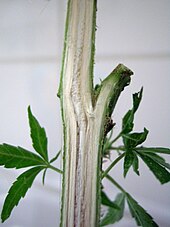
The term hemp is used to name the durable soft fiber from the Cannabis plant stem (stalk). Cannabis sativa cultivars are used for fibers due to their long stems; Sativa varieties may grow more than six metres tall. However, hemp can refer to any industrial or foodstuff product that is not intended for use as a drug. Many countries regulate limits for psychoactive compound (THC) concentrations in products labeled as hemp.
Cannabis for industrial uses is valuable in tens of thousands of commercial products, especially as fibre[121] ranging from paper, cordage, construction material and textiles in general, to clothing. Hemp is stronger and longer-lasting than cotton. It also is a useful source of foodstuffs (hemp milk, hemp seed, hemp oil) and biofuels. Hemp has been used by many civilizations, from China to Europe (and later North America) during the last 12,000 years.[121][122] In modern times novel applications and improvements have been explored with modest commercial success.[123][124]
In the US, "industrial hemp" is classified by the federal government as cannabis containing no more than 0.3% THC by dry weight. This classification was established in the 2018 Farm Bill and was refined to include hemp-sourced extracts, cannabinoids, and derivatives in the definition of hemp.[125]


The Cannabis plant has a history of medicinal use dating back thousands of years across many cultures.[126] The Yanghai Tombs, a vast ancient cemetery (54 000 m2) situated in the Turfan district of the Xinjiang Uyghur Autonomous Region in northwest China, have revealed the 2700-year-old grave of a shaman. He is thought to have belonged to the Jushi culture recorded in the area centuries later in the Hanshu, Chap 96B.[127] Near the head and foot of the shaman was a large leather basket and wooden bowl filled with 789g of cannabis, superbly preserved by climatic and burial conditions. An international team demonstrated that this material contained THC. The cannabis was presumably employed by this culture as a medicinal or psychoactive agent, or an aid to divination. This is the oldest documentation of cannabis as a pharmacologically active agent.[128] The earliest evidence of cannabis smoking has been found in the 2,500-year-old tombs of Jirzankal Cemetery in the Pamir Mountains in Western China, where cannabis residue were found in burners with charred pebbles possibly used during funeral rituals.[129][130]
Settlements which date from c. 2200–1700 BCE in the Bactria and Margiana contained elaborate ritual structures with rooms containing everything needed for making drinks containing extracts from poppy (opium), hemp (cannabis), and ephedra (which contains ephedrine).[131]: 262  Although there is no evidence of ephedra being used by steppe tribes, they engaged in cultic use of hemp. Cultic use ranged from Romania to the Yenisei River and had begun by 3rd millennium BC Smoking hemp has been found at Pazyryk.[131]: 306 
Cannabis is first referred to in Hindu Vedas between 2000 and 1400 BCE, in the Atharvaveda. By the 10th century CE, it has been suggested that it was referred to by some in India as "food of the gods".[132] Cannabis use eventually became a ritual part of the Hindu festival of Holi. One of the earliest to use this plant in medical purposes was Korakkar, one of the 18 Siddhas.[133][134][self-published source?] The plant is called Korakkar Mooli in the Tamil language, meaning Korakkar's herb.[135][136]
In Buddhism, cannabis is generally regarded as an intoxicant and may be a hindrance to development of meditation and clear awareness. In ancient Germanic culture, Cannabis was associated with the Norse love goddess, Freya.[137][138] An anointing oil mentioned in Exodus is, by some translators, said to contain Cannabis.[139]
In modern times, the Rastafari movement has embraced Cannabis as a sacrament.[140] Elders of the Ethiopian Zion Coptic Church, a religious movement founded in the U.S. in 1975 with no ties to either Ethiopia or the Coptic Church, consider Cannabis to be the Eucharist, claiming it as an oral tradition from Ethiopia dating back to the time of Christ.[141] Like the Rastafari, some modern Gnostic Christian sects have asserted that Cannabis is the Tree of Life.[142][143] Other organized religions founded in the 20th century that treat Cannabis as a sacrament are the THC Ministry,[144] Cantheism,[145] the Cannabis Assembly[146] and the Church of Cognizance.
Since the 13th century CE, cannabis has been used among Sufis[147][148] – the mystical interpretation of Islam that exerts strong influence over local Muslim practices in Bangladesh, India, Indonesia, Turkey, and Pakistan. Cannabis preparations are frequently used at Sufi festivals in those countries.[147] Pakistan's Shrine of Lal Shahbaz Qalandar in Sindh province is particularly renowned for the widespread use of cannabis at the shrine's celebrations, especially its annual Urs festival and Thursday evening dhamaal sessions – or meditative dancing sessions.[149][150]
Cannabis is called kaneh bosem in Hebrew, which is now recognized as the Scythian word that Herodotus wrote as kánnabis (or cannabis).
Cannabis is a Scythian word (Benet 1975).
cite book: CS1 maint: location missing publisher (link)cite book: CS1 maint: location missing publisher (link)cite book: CS1 maint: location missing publisher (link)During the festival the air is heavy with drumbeats, chanting and cannabis smoke.
Generational Health Dispensary is hands down the place to go for top-tier products at the most competitive prices in town! 🌿✨ I’ve been to quite a few dispensaries, and nothing comes close to the quality, variety, and value they offer here. The products? Incredible! Whether you’re looking for flower, edibles, or concentrates, every item is clearly chosen with care. The freshness and potency are unmatched—I can genuinely say I’ve never had a better experience. The prices? Let’s just say you’ll get more than your money’s worth. It’s rare to find this level of quality without breaking the bank, and their deals make it even better. On top of all that, the staff are absolute gems—super friendly, knowledgeable, and always happy to guide you to exactly what you need. If you’re looking for the best in town, stop searching and head to Generational Health Dispensary. Trust me, you’ll thank yourself for it. 🌱💚
Generational Health Dispensary is an absolute gem! From the moment you walk in, you know you’re in for something special. Let’s talk about the flavors—WOW. Every strain I’ve tried has been packed with rich, complex tastes that are just as enjoyable as the effects. Whether you’re into fruity, earthy, or gassy profiles, they’ve got it all dialed in. It’s clear their team cares about quality and consistency because the flavor alone keeps me coming back! But what really sets them apart? The budtenders. They are some of the friendliest, most knowledgeable folks I’ve met. Whether you’re a seasoned connoisseur or new to the scene, they take the time to understand your needs and guide you to the perfect product. Their recommendations are always spot-on, and you can tell they genuinely love what they do. With unmatched quality, great prices, and amazing service, Generational Health Dispensary is my go-to spot. Do yourself a favor—stop by and see what everyone’s raving about. You won’t regret it! 🌿🔥